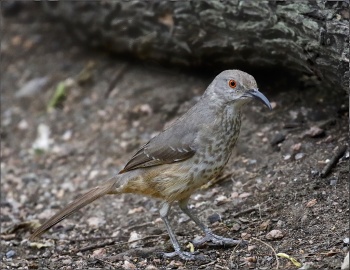- Toxostoma curvirostre
Identification

Photo © by Jones Stanley Jones
Harlingen Arroyo Colorado, Harlingen, Cameron County, Texas, USA, April 2019
25·5–28 cm (10-11 in)
This species shows mostly light brown to buffy colors.
Eyes are yellow to orange, bill is dark and slightly downcurved, less curved and shorter in juvenile. Throat is often whitish with a dusky malar stripe, lores are slightly dusky, there is a hint of a light supercilium, and the entire underside is lighter than the upperside.
Variations
Differentiation between the Eastern curvirostre group and the Western palmeri group (see section on Taxonomy) relies mainly on more contrastingly patterned breast and abdomen, more visible wing bars, and on stronger white spots at the tips of the tail feathers in the curvirostre group.
Distribution
Curve-billed Thrasher is found in Mexico from just north of the Isthmus to Texas, New Mexico, and Arizona, as well as the driest corners of Oklahoma, Kansas, and Colorado. The separation of the two main groups (see Taxonomy section) is supposed to be caused by the Sierra Madre Occidental in Mexico and continue into Arizona, where there is an overlap in the south-east corner.
Taxonomy
This species has traditionally been divided into seven subspecies. A paper by Rojas-Soto1 (2003) argues that this treatment is wrong, and that instead there is a main division into an Eastern group called the curvirostre group and a Western group called the palmeri group. In addition, populations on Tiburon and San Esteban Islands in the Gulf of California should be recognized as either full species or a subspecies. This split of Curve-billed Thrasher has not (at least yet) been recognized by the major world-wide taxonomic authorities, but the recognition of two groups that differ from each other in morphology was also made in Howell and Webb's guide to the birds of Mexico and northern Central America. If the split were to be accepted, one group would become Western Curve-billed Thrasher Toxostoma palmeri and the rest would retain the scientific name Toxostoma curvirostre (for ranges, see above).
Subspecies
There are 7 subspecies currently recognised by Clements[1]:
Eastern group
- T. c. celsum:
- T. c. oberholseri:
- Southern Texas to north-eastern Mexico (eastern Coahuila, Nuevo Le¢n and Tamaulipas)
- T. c. curvirostre:
- Southern Mexico (south-eastern Jalisco to Guerrero, Mexico, Puebla and Oaxaca)
Western group
- T. c. palmeri:
- Arid southern Arizona to western Mexico (central Sonora)
- T. c. maculatum:
- North-western Mexico (southern Sonora to northern Sinaloa and south-western Chihuahua)
- T. c. insularum:
- Islands in Sea of Cortes (San Esteban and Tiburon)
- T. c. occidentale:
- North-western Mexico (southern Sinaloa, Nayarit, north-western Jalisco and western Durango)
Habitat
Deserts and brushland.
Behaviour
Diet
Their diet consists mostly of insects, such as beetles and other arthropods; flowers and fruits, with cactus fruit being particularly important.
Breeding
They are monogamous. Their nest is a cup woven from thorny twigs. The clutch contains 2-4 speckled brown bluish-green eggs which are incubated by both adults for 13 days. The young fledge after a further 14-18 days.
References
- Clements, J. F., T. S. Schulenberg, M. J. Iliff, D. Roberson, T. A. Fredericks, B. L. Sullivan, and C. L. Wood. 2018. The eBird/Clements checklist of birds of the world: v2018. Downloaded from http://www.birds.cornell.edu/clementschecklist/download/
- A paper describing the analysis claiming two species is warranted is found here, supported here
- Handbook of the Birds of the World Alive (retrieved May 2019)
Recommended Citation
- BirdForum Opus contributors. (2025) Curve-billed Thrasher. In: BirdForum, the forum for wild birds and birding. Retrieved 29 April 2025 from https://www.birdforum.net/opus/Curve-billed_Thrasher
External Links
GSearch checked for 2020 platform.1




